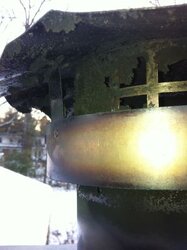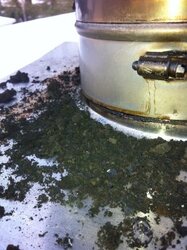This is my second year burning using a model 74 Buck. This is the driest wood I have used yet. It is hardwood slabs split in April, no bark. The attached pictures show my creosote problem on the flue cap. The stove was letting a little smoke back into the room when I opened the door, so I went up to the cap to check for any obstruction. The cap was 70-80% blocked with creosote. When the stove is running during the day, it burns so cleanly that I don't see any smoke coming out the flue, just heat. At night, I load it up and choke it back to make it last, so I assume this is when I am accumulating creosote.
So, what is the trick to still have coals in the morning, but avoid the heavy creosote buildup? The stove doesn't use a cat but it has the secondary burning tubes that allow it to burn so clean. It only has an intake air control with no damper control.
Thanks for a great website.
John
So, what is the trick to still have coals in the morning, but avoid the heavy creosote buildup? The stove doesn't use a cat but it has the secondary burning tubes that allow it to burn so clean. It only has an intake air control with no damper control.
Thanks for a great website.
John




